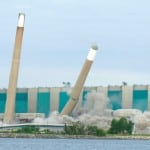In Canada, as in the U.S., where you live determines the type of generation technology that provides your power. Here’s how the four most energy-intensive provinces in Canada are responding to the challenge of providing reliable and cheap power in a sustainable way.
Due to the relative benefits of the different generation types, and their availability, Canadian policymakers in different provinces have taken very different approaches to their energy markets. Arda Yetisen, president of AEDON Consulting, a Vancouver-based engineering firm that specializes in utility services, believes their policies will be key: “I can’t see great leaps in technology occurring. But taking proven methods, making the right decisions for the province and the country, and applying them effectively is what will be most important.”
Ontario Dumps Coal for Cleaner Options
Ontario has attracted the attention of the global power community as it pursues a number of strategies to revolutionize its electricity system under the “Green Energy Act” that was passed in April 2009. Ontario has launched one of the broadest and most competitive feed-in tariff programs in North America and aims to remove all coal-fired generation from its mix. (See “The Feed-in Tariff Factor” in POWER’ s September 2010 issue for details of this and other feed-in tariff programs.) The province has also launched the most comprehensive roll-out of “smart metering” in North America.
“We’re in the midst of a generational change in energy that has taken place over the past seven years in Ontario,” says Brad Duguid, the Ontario Minister for Energy. “It is providing a budding green energy economy, creating the next generation of jobs, while at the same time creating cleaner air.”
The province of Ontario operates a 35,000-MW electrical system with a winter peak of 27,000 MW that provides electricity for 13 million people. Nuclear power accounts for almost half of the generation mix, which also includes significant hydro, gas, coal, wind, and solar assets. (See “Canada Moves to Rebalance Its Energy Portfolio,” in POWER’ s June 2009 issue.)
The Ontario Power Authority (OPA) was created in order to enable private investment in generation. “There was a period of time when the proper attention was not being paid to making sure we were getting supply in place. Suppliers often didn’t have confidence in the province, so we needed to come in and be a credit-worthy counterparty,” explains the OPA’s CEO, Colin Anderson. Developers enter into a contract with the OPA to enable the financing required to build long-term generation at a regulated rate of return.
Despite the participation of a strong independent power producer (IPP) community in Ontario, the majority of generation remains under the control of Ontario Power Generation (OPG). Tom Mitchell, CEO of OPG, says: “We generate between 60% and 70% of the energy in the province and view ourselves as the low-emission, low-cost energy backbone of Ontario. In many ways we are a foundation and an enabler to what is being done to change the supply mix in Ontario, including the developments in renewable and distributed energy. We are aggressively engaged to make the necessary investment to ensure that nuclear, hydro, and our thermal fleet is there to keep the lights on.”
 |
| Tom Mitchell, CEO, Ontario Power Generation |
Building a Green Economy. Minister Duguid makes no secret of the fact that a key motivation behind the province’s “Green Energy Act” is job creation and economic development: “We agree with President Obama when he says that the jurisdiction that leads the green energy economy will be the jurisdiction that leads the international economy. Ontario is now a leader in building a green energy economy. We’re estimating 50,000 jobs being created as a result, and we’re already seeing those jobs arrive across our province. The result is jobs being created and green energy enterprises popping up.”
David McFadden is a partner at Gowlings, a law firm with a large practice dedicated to power project development law. He has seen first-hand the buzz that this policy has created: “As a result of the Green Energy Act, in addition to the new and established Canadian players, we now have clients from Korea, U.S., China, and the European Union. Ontario has gone from a jurisdiction that was not well known for its green economy to a province that is considered innovative and highly interesting to the renewable energy community.”
EDF EN, a renewables-focused subsidiary of French utility EDF, has noted the opportunity and has invested more than a quarter of a billion dollars in Ontario solar projects (Figure 1). Jon W. Kieran, director, solar, EDF EN Canada, describes his company’s interest: “We feel that Canada is going to be one the most robust renewable energy markets in the world for a sizable period of time. Firstly, it is endowed with the natural resources to make renewable energy profitable here. Secondly, there is a unique history of the development of the energy industry’s infrastructure. Canada, and Ontario in particular, is disproportionally well invested in the area of energy. Thirdly, and most importantly, the Ontarian government was the first jurisdiction in North America to create a European-style feed-in tariff, thereby achieving a far-reaching policy perspective on creating green energy industries.”
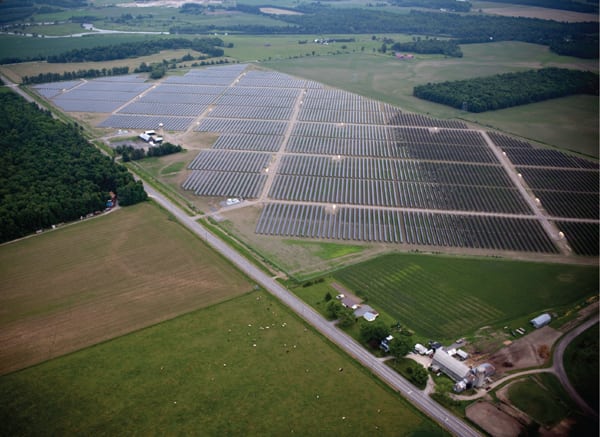 |
| 1. Rows of panels. The 23.4-MW Arnprior Solar Project near Ottawa, Ontario, began commercial operation in 2009. Courtesy: EDF EN |
The development market is a mixture of established players and new entrants. The Association of Power Producers of Ontario (APPRO) represents their concerns. APPRO President David Butters highlights how the IPP community’s greatest desire is now for policy stability that would enable better financing of power projects: “People are just looking for a stable regime. A big part of the value proposition of power investments is their 20-year time frame. In order to raise money at the minimum cost, you need to have assurance of what the climate is going to be like throughout that cycle.”
Closing Coal Plants. One of the key initiatives in Ontario is eliminating coal from the supply mix. Its contribution has already been reduced from 19% in 2005 to 7% in 2009, and the remaining capacity should disappear by 2014.
“Our premier decided to get out of dirty coal-fired supply, and by 2014 we will be the first jurisdiction in the world to accomplish that goal. We’ve seen a 70% reduction, and we’re at the lowest level of coal generation in 45 years. We’re closing four more coal plants by the end of 2010, four years ahead of schedule,” says Minister Duguid.
This policy will account for the majority of the government’s greenhouse gas reduction target by 2014. “When you look at the reduction that this will make to greenhouse gas emissions, it’s one of the largest climate change initiatives in all of North America,” says the OPA’s Anderson.
Two units at the Thunder Bay coal plant will be converted to gas, and Atikokan will be converted to biomass. OPG’s Mitchell sees this as a great opportunity for the province: “We’ve been directed by the government to proceed with the detailed work to repower Atikokan Generating Station with biomass. As other utilities and entities around North America look to replace coal, Ontario has the opportunity to lead the way. This could generate a ‘made in Ontario’ fuel supply for use here, across Canada, and perhaps the world.” (See “OPG Charts Move from Coal to Biomass” in POWER’ s April 2010 issue for details of the repowering plan.)
A Critical Decade for Canada’s Nuclear Hub. Ontario has about 95% of the country’s total nuclear generation and is home to Atomic Energy Canada Ltd. (AECL) and the nation’s greatest nuclear energy services hub. This is a critical decade for Ontario’s nuclear industry, not only due to the new build decisions, but also because of the need to refurbish and extend the life of the existing fleet.
OPG owns a nuclear fleet of three facilities, the largest of which is leased to Bruce Power, while OPG operates the Pickering and Darlington Nuclear Power Stations that have a combined generating capacity of about 6,600 MW. OPG is proceeding with a mid-life refurbishment of the Darlington Nuclear Station (Figure 2) and continuing safe operation of the Pickering Nuclear Station for about a decade with a $300 million investment.
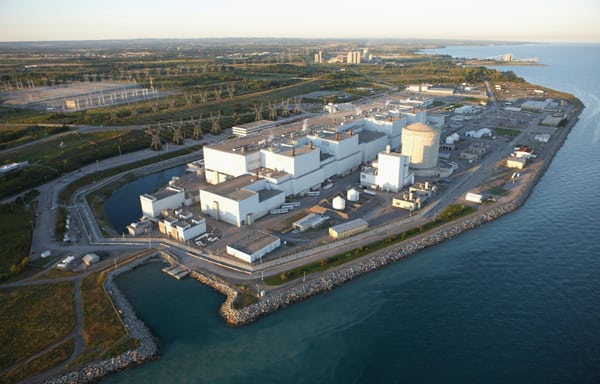 |
| 2. Big baseload provider. The four-unit Darlington Nuclear Generating Station has a total capacity of 3,524 MW and is located in the Municipality of Clarington, 70 km east of Toronto. It provides about 20% of Ontario’s power. During the Darlington refurbishment project, each unit will be refurbished sequentially. Courtesy: Ontario Power Generation |
OPG’s Mitchell fully understands the importance of Ontario’s nuclear history: “Ontario has been in the nuclear business for over 40 years and has designed, developed, and built a very viable technology that has been deployed across the world. As we renew the facilities here, we will be renewing our workforce to retool and service both Ontario’s needs and support the safe, reliable, and economic deployment of nuclear energy around the world. Many specialists that have worked in the nuclear industry since its early days are now reaching retirement. What is exciting to me is the number of young people that are interested to work in the nuclear industry. We often talk about the physical equipment, but nuclear energy, more than any form of generation, is actually very much a people business.”
Bruce Power was founded in 2001 as Canada’s first privately owned nuclear operator. It manages eight 750-MW CANDU reactors. Bruce Power was formed originally to refurbish these assets. In its 10 years the company has refurbished two of its units and is now in the late stages of refurbishing two more. (See “Bruce A Proves There Are Second Acts in Nuclear Power” in POWER’ s August 2010 issue for details of this project.)
McFadden feels that this private participation rejuvenated the nuclear sector: “Bruce Power had a wonderful impact on the Tiverton community. The refurbishment project was able to move ahead, thousands of jobs were created, the community was stabilized, and a strong company with an excellent management team was created.”
Duncan Hawthorne, president and CEO of Bruce Power, has his sights on refurbishing the remaining four units. “We remain focused on nuclear operations. You will see us commit to the $12 billion investment in the refurbishment of the rest of our fleet. The market needs it, and the economics are compelling. That is under our own control, and within two years we should have made that commitment. There is no ideological opposition to this; it is just a matter of negotiating the terms.”
Hawthorne is now looking to grow the size of Bruce Power to increase efficiencies: “Nuclear power stations are like potato chips: You can’t have just one. Running one single CANDU unit means you have a lot of overheads. Considered purely on an operational basis, plants operate better economically when part of a larger utility.”
The OPG begins its own refurbishment campaign at Darlington with confidence. Mitchell explains: “We’ve learned from our own experience and have also been very closely following the experience of other refurbishments. We’re actively engaged in being a sponge to the various lessons learned in not only technical issues, but also project management, contract structure, risk mitigation, and a whole host of things.”
“We’ve focused very hard over the past three years on some very important nuclear projects internal to our company. Every 10 years we have to shut down our reactors for essential maintenance, which has been successfully achieved last year at Darlington and this year at Pickering. We also made a decision in 2005 to put two of our Pickering units into decommission, and we have just achieved this ahead of schedule and under budget. There was a lot of learning from that project in not only the planning but also in the choreography of the execution.”
One of the unique elements of the Darlington refurbishment project is that the multi-unit station will be refurbished sequentially. Mitchell explains: “We’ll be refurbishing a unit while operating the other units. The Pickering shutdown was also achieved in this manner; we were doing major work on two of the units while operating two of the units. ‘Choreography’ is the best word I can use to describe the process that has to occur between the operator and the refurbishment operation. We’ve learned that you can’t split the two. They have to be very tightly integrated. We have also learned that the amount of planning and the ability to very precisely understand the scope of the work before you start is crucial. We are not planning on starting the Darlington refurbishment until 2016, but we have already started the intense planning six years ahead of schedule to precisely determine the scope. We are also engaging the private sector to come up with innovative ideas on how to do the work, particularly in the integration between the refurbishment and operational units.”
Feed-in Frenzy. A cornerstone of the Green Energy Act is the feed-in tariff (FIT) program. The FIT program establishes an open and guaranteed stable price structure under long-term contracts in order to make renewable electricity development economically viable. More than 1,000 FIT contracts are currently in place for clean energy projects. Minister Duguid enthusiastically supports the program: “We are leading the charge on green energy. The feed-in tariff system that Germany and Spain operate has been something we’ve looked at, and we’ve come up with our own Ontario version. Our FIT program has gone from design to launch in just a year and a half, and we’ve just awarded 2,500 megawatts of contracts. That’s $9 billion worth of activity.”
In order to ensure maximum benefit from the blossoming of the green economy, these contracts include the caveat that participants must include a 50% minimum of local content in every project. This has led to a number of success stories for the provincial government, the largest of which has been the $7 billion investment by a consortium that includes Samsung and Siemens, which have invested in a photovoltaic inverter and a wind turbine plant.
William Smith, senior vice president of the energy sector at Siemens Canada, explains: “When we looked at the potential in Ontario and the loyal customers that we had accumulated in the development community, we saw that it made sense as a manufacturing center. The factory is designed to meet local content rules for any developer, including the Samsung Consortium, and is a logical extension of our global supply strategy for wind turbines. Our first priority is to serve the Ontario market, then over time to export as a part of the overall supply chain within North America.”
 |
| William Smith, senior vice president, energy sector, Siemens Canada |
Smith notes, “This process began three or four years ago when Ontario started to open up its renewable market and we started developing wind projects. The success of these projects demonstrated our ability to realize project costs effectively and on time, which has allowed us to capture over 50% of the market over the last 18 months.”
Ensuring that green energy jobs are created is a vital way of demonstrating the value of the policy to rate payers. Nevertheless, the domestic content requirement terms of the FIT program have been criticized by some as a protectionist measure that is not in the interest of establishing truly efficient renewable energy supply chains.
Despite these concerns, it is clear that the international renewable energy community sees this as a huge opportunity. “Ontario has begun a program to create a renewable energy hub through its progressive government policy. These programs represent the most attractive incentive that exists in North America for solar development,” says EDF EN Canada Inc.’s Kieron.
Québec Capitalizes on Hydro
Québec has a population of 7.8 million, an installed capacity of 38,000 MW, and a winter peak of 34,000 MW. The province is served principally by Hydro-Québec, a government-owned monopoly that is Canada’s largest utility, operating one of the biggest systems in Canada for the generation and distribution of electric power. Hydro-Québec manages 83 generating facilities that supply virtually all of the electric power distributed in Québec. In 2009, Québec exported about $1.5 billion worth of electricity and the government of Québec received more than $2.17 billion in dividends.
Québec’s greatest energy resource is its hydropower, which generated about 97% of the province’s electricity in 2008. Other sources of electricity include nuclear, wind, and thermal generation. As most of Hydro-Québec’s generation stations are located at substantial distances from consumer centers, its transmission system is one of the most extensive and comprehensive in North America.
While other Canadian provinces had periods of little or no generation development, Québec has remained fairly consistent in building new assets. Since 2003, Hydro-Québec has commissioned eight new hydropower facilities and currently has six more projects under construction. The company’s total investments in generation, transmission, distribution, and energy efficiency for the 2009–2013 timeframe are expected to reach $25.1 billion. In April 2010, Minister of Natural Resources and Wildlife Nathalie Normandeau announced the latest strategy, which included spending an additional $32 billion by 2035 to expand capacity by 3,500 MW.
Québec also hosts one nuclear generating station, Gentilly 2, which has a net installed capacity of 635 MW. The facility began commercial generation in 1983 and is currently undergoing a $1.9 billion refurbishment that is expected to be completed by 2012.
“The power business has been very strong in Québec, and we see that continuing,” maintains Denis Tremblay, president of the Power Division at BPR, a multi-disciplinary engineering firm that has been active in power generation for 10 years and has developed close ties with Hydro-Québec as a preferred supplier. “The government and its utility have committed to a great deal more investment in generation, and that will also come with the need for increased interconnection and lots of grid improvements.”
Quebéc IPPs. Although Hydro-Québec remains the dominant player, opportunities for IPPs do exist in Québec. Hydromega became the province’s first IPP in 1987 and has since developed a series of hydro and wind power projects. Jacky Cerceau, president and CEO of Hydromega (Figure 3), relates: “Hydro-Québec launched a series of RFPs [requests for proposals] in the early nineties. It led to the development of a series of privately developed projects. They were mostly hydro but also included some wind and biomass. In 2002, the focus of Hydro-Québec was mainly on hydro. However, suitable hydroelectric projects were becoming more and more difficult to find, there was opposition from the community, and it was difficult to build a greenfield project.”
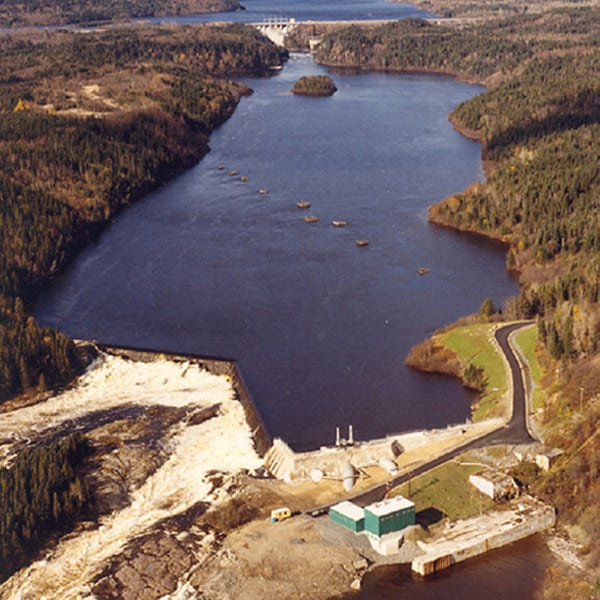 |
| 3. From mill to power. The Sainte-Marguerite I hydroelectric generating station is 25 km west of Seven Islands, Québec, on the first set of falls on the Sainte-Marguerite River. The facility is located on the site of an abandoned wood mill originally used for pulp and paper manufacture.The mill ceased operations in 1968, and the site was idle for 20 years before being acquired by Hydromega in 1989. At the base of the existing dam, an entirely new generating station was constructed between April 1992 and December 1993. It is powered by an 8,500-kW Francis turbine. Courtesy: Hydromega |
Hydro-Québec decided to broaden its generation mix. It launched an RFP in order to stimulate the development of 1,000 MW of wind generation. Cerceau continues: “The first RFP was focused purely on the Gaspé Peninsula region and included a 30% domestic content requirement, as part of the intention was to open up development in the Gaspé region. This region had become very economically depressed but possessed an excellent wind regime. This has been a very successful policy for the region. After the success of the first RFP, Hydro-Québec launched a second 2,000-MW RFP.”
“The key benefit of wind in Québec is in its combination with the phenomenal hydro assets. The load peak for Québec is in winter, which is when there are also the strongest wind conditions. The province already has a great dispatchable hydro resource and can now use this more for export purposes, as increasing domestic supply can be met by wind,” calculates Helmut Herold, regional manager for Québec and East Canada with REpower Systems, one of the world’s leading manufacturers of onshore and offshore wind turbines. REpower Systems manufactures towers, blades, and converters in Québec and is now preparing for towers and blades to be constructed in Ontario.
A third call for tenders, this time for 500 MW of wind power, is expected to proceed. This new capacity will increase total wind power installed capacity in Québec to 4,000 MW by 2015, which represents approximately 10% of the total peak demand (if wind operated at 100% capacity, which it does not). In the longer term, additional calls for tenders will follow at the rate of 100 MW of wind power for each 1,000 MW of additional hydroelectric power developed by Hydro-Québec.
“By 2016, there will be over 3,600 MW of wind generation in Québec,” predicts Michel Famery, vice president for national development of energy and telecom at Dessau, an engineering firm that participates in wind development in the interconnection process. “New types of energy are sometimes difficult to access or are inconsistent for the grid system. Therefore, we are looking to optimize their connection to the grid and to ensure their stability.”
The largest wind development in the region is that of the St-Laurent Energy Consortium, made up of European renewable energy giants REpower Systems AG, EDF EN, and RES Canada. These partners created a framework in order to develop, construct, and operate five wind farms with a combined capacity of up to 954 MW. “The St-Laurent Energy project represents one of the largest wind projects in North America and the biggest on-shore contract ever signed by REpower Systems,” says REpower Systems’ Herold.
“Québec’s government very sensibly entered the market early and mobilized people to establish a production beachhead in Québec. They are now feeding that market with tenders. Québec could very easily exceed the 10% wind mix that they have targeted. Depending on the nature of the U.S. market, Québec is extremely well placed to become a renewable energy powerhouse for the Northeast. It is not unforeseeable that Québec would have a 40% wind penetration in its mix,” observes Peter Clibbon, vice president, RES Canada Inc.
Québec Develops Engineering Expertise into an Exportable Commodity. Since the Carillon project of 1960, Hydro-Québec has pursued a policy of outsourcing its engineering needs. This has spawned an engineering consultancy industry within the province. Québec has now developed a reputation worldwide as a hub for excellence in engineering services. The province is the home to some of the largest engineering firms in the world.
The role of the Québec government and Hydro-Québec as drivers for this industry can be seen in the histories of many of its now internationally regarded engineering firms. “Hydro-Québec has been wonderful at working with consultants on their major projects so that local companies have gained expertise, which we can then export and employ on projects around the world,” believes Dessau’s Famery. “We started in the power business by working with Hydro-Québec on the James Bay project in the seventies. Based on that, and further work with Hydro-Québec, we built strong expertise and were able to compete on projects internationally.”
Bernard Poulin, president and CEO Groupe SM, another Québec engineering firm that has gone on to make a great impact in power projects worldwide, remembers: “I started the company as a student focusing on soil testing. After four years of knocking on the door of Hydro-Québec, we were given the contract to work on the road for the James Bay Project in 1976. Hydro-Québec was impressed with our work and gradually gave us more responsibility, which allowed us to grow and gain experience as a consultant in both civil and electrical projects.”
“Compared to companies that had only worked on small regional projects, Hydro-Québec got us involved in a multitude of specialized expertise that you could only find on a project of that magnitude,” Poulin explained. “That gave us the expertise to go elsewhere. What they did and the way they did it was first-class management.”
British Columbia Boasts Green Energy
British Columbia (BC) has a population of 4.5 million, an installed capacity of 13,100 MW, and a winter peak of 10,000 MW. Like Ontario and Québec, BC sees a green economy as key to the province’s future and, like Québec, it is blessed with a large heritage hydro fleet that provides clean, dispatchable energy, which it can use for trade. BC is now considered the most exciting area in North America for small hydro development and claims a vibrant run-of-river development community.
“We see ourselves as having the potential to include green energy as an important part of our economy. Green energy investments have been taking place for quite a long time in BC. We think we are well positioned to become a clean energy powerhouse in North America,” determines Bill Bennett, the BC minister for Energy, Mines and Petroleum Resources. “BC sees about 21% of all the venture capital that comes into the country. Given the size of our province and of our economy, it shows we’re an exciting place to be these days.”
In April 2010, the Government of British Columbia passed its Clean Energy Act, whose objectives fall under three broad categories: ensuring electricity self-sufficiency at low rates; creating new investments in clean, renewable power and energy security; and harnessing BC’s clean-power potential to create jobs in every region.
BC consumers have enjoyed a long history of affordable, principally hydro-based, power supplied by the government-owned monopoly utility, BC Hydro. BC Hydro accounts for 80% of the province’s total capacity to generate electricity, mostly from dams on the Peace and Columbia Rivers. These facilities account for 85% of BC Hydro’s annual generation; the balance is produced through thermal generation, mostly fueled by natural gas. “BC Hydro is in an enviable position; we have 90% hydro from 33 hydroelectric facilities. This is complimented by a few small gas plants and wind, run-of-river hydro, and biomass generation provided through IPPs,” explains Bev Van Ruyven, deputy CEO and executive vice president, BC Hydro.
BC Hydro has indicated that electricity demand is expected to grow by up to 45% over the next 20 years. New demand will be greatest in the Lower Mainland and Vancouver Island regions, which consume about 70% of the province’s electricity. As discussed below, a portion of this supply is expected to be provided by IPPs providing clean energy.
Between 1960 and 1984, BC completed six large hydro projects. The province then underwent 16 years of inactivity in power generation development until a political shift in 2001 opened generation opportunities to the private sector. “IPPs have begun to play an enormous role over the past eight years in all of our programs,” says Van Ruyven. “We have gone from having none eight years ago, to currently having over 100 contracted private partnerships. By 2016 the private sector will provide around 25% of our supply.”
Run-of-River Hydro Expertise. BC is now recognized as a small hydro hub for North America. A 2008 study commissioned by BC Hydro found that there were more than 8,000 sites with the potential to be developed as run-of-river projects in BC. “Going green means that you work with what mother nature gives you. In BC it’s given you rain and mountains. BC is fairly unique in terms of rainfall, and the number of high-head potential projects makes run of river schemes very economical,” says Sam Mottram, manager of power services at Knight Piesold.
Knight Piesold has been identifying potential run-of-river sites in BC since 1979. “We identified 30 sites that no one had looked at because they were so far from the grid. But we came up with a green corridor concept, whereby a cluster of generation would carry the cost of development and make these projects feasible. It was a great idea but just needed a developer with the same vision.”
One such project was the recently commissioned 236-MW Toba Montrose site (Figure 4). This was identified by Knight Piesold and developed by Plutonic Power. Donald McInnes is the founder, vice chair, and CEO of Plutonic Power: “Most people were building where resources coincide with roads and transmission. In BC, this was limited to two or three main places. We didn’t want to be constrained that way. Prior to Plutonic Power, the average project size was around 10 MW. We felt that development in those increments was not going to change the supply problem.” Using Knight Piesold’s green corridor concept, Toba Montrose is just the first in a series of developments that were clustered to make the necessary transmission investments viable.
 |
| 4. Rubber dam. In 2010, Plutonic Power completed the Toba-Montrose run-of-river project, which consists of a 73-MW facility on Montrose Creek and a 123-MW facility on East Toba River. It is the largest source of privately generated renewable power in B.C. and the largest run-of-river project in the province. This photo shows the East Toba Hydroelectric Facility’s inflatable rubber dam and intake. Courtesy: Knight Piesold |
Regional Power is an IPP that specializes in hydroelectricity and has over 240 MW of projects in development. “In spite of the initial financial commitment, a hydro plant boasts technological longevity and economic durability—it is an attractive and lucrative asset in terms of investment. It is green, it is clean, and it ultimately becomes very economical,” says Colin Cooligan, president of Regional Power. His company’s award-winning Sechelt Creek generating station exemplifies the measures being taken by these developers to limit their environmental impact and engage with indigenous communities (Figure 5).
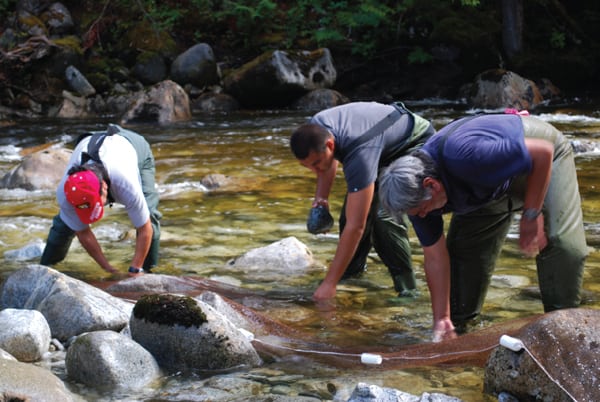 |
| 5. Salmon spawn in the Sechelt. Members of Sechelt First Nation Resource Management Department monitor salmon in Sechelt Creek, near the tailrace for the 16-MW run-of-river Sechelt Creek Generating Station. The success of a manmade 400-meter salmon-spawning channel, created as part of the power project development, has enhanced salmon population in the creek. Courtesy: Regional Power |
At the Sechelt development, a productive salmon-spawning channel was successfully installed, and the facility is used as a training center for First Nation students who are eager to participate in the industry. David Carter, executive vice president of Regional Power, feels that these measures are vital in order for the industry to meet its potential: “The future for hydro in Canada is fabulous. The forgiveness, efficiency, and timelessness of the technology is unsurpassable. It is the hardest business to enter but by far the most attractive business to be in for the long term.”
Bioenergy Edge. In addition to its drive for additional hydro and wind, bioenergy development is also encouraged in BC due to the potential synergies with its long-established pulp and paper industry. “Power in biofuel is becoming increasingly important in this province and across Canada,” says Ulf Tryggvesson, executive vice president of Pöyry (Vancouver) Inc. “At present, it’s an unutilized resource. There are large amounts of biomass that are either being destroyed or landfilled due to the lack of a market for it. BC has the opportunity here to not only address its power generation needs but to also help maintain one of its oldest industries.”
Alberta Backs Fossil Technologies
Alberta has a population of 3.7 million, an installed capacity of 12,900 MW, and a winter peak of 10,300 MW. Since 1996, Alberta has operated fully competitive wholesale and retail electricity markets. “We operate the only truly open market in Canada. We pay for our electricity as we go, no debt is buried in Crown Corporations, and we are doing it all in a market without the natural advantage of hydroelectricity or other cheap renewables,” explains Ron Liepert, Alberta’s Minster of Energy. “If you have a mindset of free enterprise, I don’t think there’s a better place to invest.”
Alberta’s fossil fuel resources include large reserves of crude oil and natural gas as well as a vast reserve of coal. Coal production in Alberta totaled 32.5 million metric tons in 2008, and total coal reserves in the province could amount to more than 30 billion metric tons. Alberta generates the most conventional thermal energy of any province, and coal-fired generation accounts for over 70% of Alberta’s mix, followed by natural gas, hydro, and wind. Although wind development is occurring in Alberta, it is one Canadian province that is not working to seed a renewable energy industry with the allure of subsidies or preferential tariff rates.
The generation sector in Alberta is dominated by a few private companies. One of these is TransAlta, which operates a range of facilities and continues to broaden its presence (Figure 6). Steve Schnyder is CEO of TransAlta and the Energy Council of Canada’s 2010 Energy Person of the Year. “We are one of the oldest power companies in Canada. We were mostly Alberta-based, but over the last 20 years we have become much more international. The biggest change we have had to embrace has been the deregulation process. From 1996 to 2005 our transformation has revolved around getting through that regulatory change. Now our focus is wholesale generation and marketing across Canada and the Western U.S.”
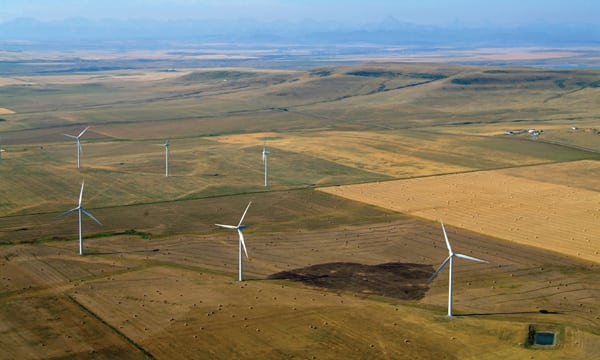 |
| 6. Alberta winds. The Summerview wind facility now has a total installed capacity of 136 MW at Pincher Creek, Alberta. Courtesy: TransAlta |
Counting on Capturing Carbon. Alberta has become a global center of excellence in the pursuit of clean solutions for coal and in the drive toward a commercial solution for carbon capture and sequestration. Minister Liepert elaborates: “We have committed to invest C$2 billion in carbon capture and storage development over 15 years. This has been channelled into four projects, one of which is being applied to coal-fired generation.”
“In this day and age, ‘carbon’ is a bad word, but people predict North America has over a hundred years’ of supply potential,” explains William Smith, senior vice president of the Energy Sector at Siemens Canada. “We believe that gasification will have a role to play in enabling North America to utilize that coal resource. We have a technology that can convert coal into a synthetic gas that can be burned in a turbine, and then the CO2 can be captured and stored. The issue today is whether we can get the economics right so that it is a feasible cost for jurisdictions. The second issue is where to store the CO2 that is captured. This represents a significant opportunity for Alberta and Saskatchewan, where it is ideal for storage and for advanced oil recovery.”
“Alberta is one of the best jurisdictions in the world for carbon capture and storage,” believes Brian Vaasjo, president and CEO of Capital Power, one of the three largest generation and development companies in Alberta. Capital Power is currently constructing a pilot carbon capture and sequestration (CCS) facility at its new Keephills 3 plant: “We have the oilfields to utilize the carbon advanced recovery. We have the natural aquifers, and people are comfortable with the idea of storing carbon beneath the ground here.”
He sees the real drive for this to be the export potential of this technology and expertise as CCS systems improve: “There’s a lot of sense in developing CCS here, but the real drive is international. Only 15% of our mix is from coal, while in China it’s 80%, India 70%, and U.S. 60%. [Ed.: The U.S. Energy Information Agency reports that coal-fired generation in 2010 accounted for 45% of total U.S. generation.] There’s going to have to be an answer to coal-fired generation.”
Exploring Nuclear Potential. Due to Alberta’s industrial boom, and the potential of carbon pricing making coal less viable as a long-term option, some players see potential for Alberta developing its own nuclear facility. Energy Minister Liepert will not rule this out. “It’s a question of economics. We won’t seed the market to make it happen. Today, in Alberta the private sector has decided that it can’t make it go.”
Despite the current lack of appetite for nuclear power, some market players see a long-term potential for adding it to the mix. “The introduction of nuclear energy makes sense in order to meet the current shortfall and to meet future demand growth linked to additional oil sand development,” says Duncan Hawthorne, president and CEO of Bruce Power. He feels that nuclear suffers from a misconception over its cost, particularly in relation to clean coal: “There is the belief that clean coal is the cheapest or most logical option. I think that people will come to the realization that while nuclear cannot compare with the low rates provided by existing coal facilities, it can compete as an alternative to any new-build coal plant. Therefore, I look at Alberta and Saskatchewan as being on a slow fuse, but that they will inevitably get to the point of considering nuclear. If nuclear is in Alberta, we’re in Alberta,” he says.
Decision Time
With its rich resource base and government policies that promote energy development, Canada is in an enviable position. However, the entire power industry is waiting on certain key decisions, one of the most important being the establishment of a clear carbon price. TransAlta’s Snyder cautions: “We have the time to get it right, but we don’t have time to get it wrong. There are a lot of options coming up. If we take some time to let it all play out, I think that’s the best approach. In our industry, when you make a decision, you’re stuck with it for a long time.”
Canada’s role as a green energy superpower is set to grow as North America’s requirements for clean power continue to increase. Power exports will remain vitally important to Canada’s electricity industry and will make possible the continued, steady investment that it so strongly desires.
— Tom Willatt and Sharon Saylor (info@gbreports.com) are with Global Business Reports.







